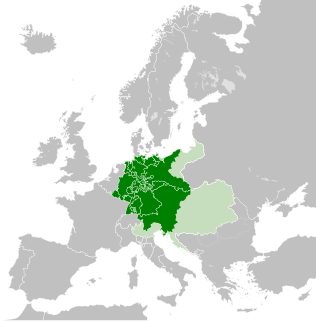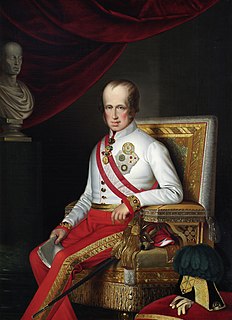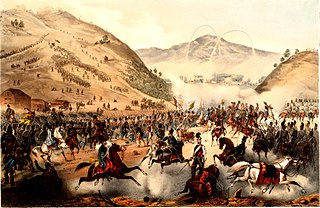
Franz Josef I or Francis Joseph I was Emperor of Austria, King of Hungary, Croatia, and Bohemia, and monarch of other states of the Austro-Hungarian Empire, from 2 December 1848 until his death. From 1 May 1850 to 24 August 1866 he was also President of the German Confederation. He was the longest-reigning emperor of Austria and king of Hungary, as well as the fourth-longest-reigning monarch of any country in European history.

The German Confederation was an association of 39 German-speaking states in Central Europe, created by the Congress of Vienna in 1815 to coordinate the economies of separate German-speaking countries and to replace the former Holy Roman Empire, which had been dissolved in 1806. The German Confederation excluded German-speaking lands in the eastern portion of the Kingdom of Prussia, the German cantons of Switzerland, and the French region of Alsace, which was predominantly German speaking.

Ferdinand I was the Emperor of Austria from 1835 until his abdication in 1848. As ruler of Austria, he was also President of the German Confederation, King of Hungary, Croatia and Bohemia, King of Lombardy–Venetia and holder of many other lesser titles. Due to his rocky, passive but good-intended character, he gained the sobriquet The Benign or The Good.

The Battle of Pákozd was a battle in the Hungarian Revolution of 1848, fought on the 29 September 1848 in the Pákozd – Sukoró – Pátka triangle. It was one of the most important battles of the revolution, in which the Hungarian revolutionary army led by Lieutenant-General János Móga defeated the troops of the Croatian Ban Josip Jelačić.

Maximilian II reigned as King of Bavaria between 1848 and 1864.

The Austrian Empire was a Central European multinational great power from 1804 to 1867, created by proclamation out of the realms of the Habsburgs. During its existence, it was the third most populous empire after the Russian Empire and the United Kingdom in Europe. Along with Prussia, it was one of the two major powers of the German Confederation. Geographically, it was the third largest empire in Europe after the Russian Empire and the First French Empire. Proclaimed in response to the First French Empire, it partially overlapped with the Holy Roman Empire until the latter's dissolution in 1806.

A set of revolutions took place in the Austrian Empire from March 1848 to November 1849. Much of the revolutionary activity had a nationalist character: the Empire, ruled from Vienna, included ethnic Germans, Hungarians, Slovenes, Poles, Czechs, Slovaks, Ruthenians (Ukrainians), Romanians, Croats, Venetians (Italians) and Serbs; all of whom attempted in the course of the revolution to either achieve autonomy, independence, or even hegemony over other nationalities. The nationalist picture was further complicated by the simultaneous events in the German states, which moved toward greater German national unity.

The 1848 Revolutions in the Italian states, part of the wider Revolutions of 1848 in Europe, were organized revolts in the states of the Italian peninsula and Sicily, led by intellectuals and agitators who desired a liberal government. As Italian nationalists they sought to eliminate reactionary Austrian control. During this time period of 1848, Italy was not a unified country, and was divided into many states, which, in Northern Italy, were ruled by the Austrian Empire. A desire to be independent from foreign rule, and the conservative leadership of the Austrians, led Italian revolutionaries to stage revolution in order to drive out the Austrians. The revolution was led by the state of the Kingdom of Sardinia. Also, the uprisings in the Kingdom of Lombardy–Venetia, particularly in Milan, forced the Austrian General Radetzky to retreat to the Quadrilatero (Quadrilateral) fortresses.

The Austro-Hungarian Compromise of 1867 established the dual monarchy of Austria-Hungary. The compromise put an end to the 18 years long military dictatorship and absolutist rule over Hungary, which was introduced by Francis Joseph after the Hungarian Revolution of 1848. The Compromise partially re-established the former sovereignty of the Kingdom of Hungary, however being separate from, but no longer subject to the Austrian Empire. The agreement also restored the old historic constitution of the Kingdom of Hungary.

The Emperor of Austria was the ruler of the Austrian Empire and later the Austro-Hungarian Empire. A hereditary imperial title and office proclaimed in 1804 by Holy Roman Emperor Francis II, a member of the House of Habsburg-Lorraine, and continually held by him and his heirs until Charles I relinquished power in 1918.

Count Josip Jelačić von Bužim was a Croatian lieutenant field marshal in a Imperial-Royal Army and politician, the Ban of Croatia between 23 March 1848 and 19 April 1859. He was a member of the House of Jelačić and a noted army general, remembered for his military campaigns during the Revolutions of 1848 and for his abolition of serfdom in Croatia.

Count Lajos Batthyány de Németújvár was the first Prime Minister of Hungary. He was born in Pozsony on 10 February 1807, and was executed by firing squad in Pest on 6 October 1849, the same day as the 13 Martyrs of Arad.

The Vienna Uprising or October Revolution of October 1848 was the last uprising in the Austrian Revolution of 1848.

The Austrian Crown Jewels is the regalia and vestments worn by the Holy Roman Emperor, and later by the Emperor of Austria, during the coronation ceremony and other state functions. The term refers to the following objects: the crowns, sceptres, orbs, swords, rings, crosses, holy relics, and the royal robes, as well as several other objects connected with the ceremony. The collection dates from the 10th to the 19th centuries and reflects more than a thousand years of European history. It is kept at the Imperial Treasury in the Hofburg Palace in Vienna, Austria.

Archduke Rainer of Austria was a Viceroy of the Kingdom of Lombardy-Venetia from 1818 to 1848. He was also an Archduke of Austria, Prince Royal of Hungary and Bohemia.

Archduke John of Austria, a member of the House of Habsburg-Lorraine, was an Austrian field marshal and imperial regent (Reichsverweser) of the short-lived German Empire during the Revolutions of 1848.

Baron Cajetan von Felder was an Austrian lawyer, entomologist and liberal politician. He served as mayor of Vienna from 1868 to 1878.

Salomon Mayer von Rothschild was a German-born banker in the Austrian Empire and the founder of the Austrian branch of the prominent Mayer Amschel Rothschild family.

Albrecht Graf von Bernstorff was a Prussian statesman.

The Hungarian Revolution of 1848 was one of many European Revolutions of 1848 and closely linked to other revolutions of 1848 in the Habsburg areas. Being one of the most determinative events in Hungary's modern history, it is also one of the cornerstones of the Hungarian national identity. The crucial turning point of the events were the April laws which were ratified by King Ferdinand I, however the new young Austrian monarch Franz Joseph I arbitrarily revoked the laws without any legal competence. This unconstitutional act irreversibly escalated the conflict between the Hungarian parliament and Franz Joseph. The new constrained Stadion Constitution of Austria, the revocation of the April laws and the Austrian military campaign against the Kingdom of Hungary resulted in the fall of the pacifist Batthyány government and led to the sudden emergence of Lajos Kossuth's followers in the parliament, who demanded the full independence of Hungary. The Austrian military intervention in the Kingdom of Hungary resulted in strong anti-Habsburg sentiment among Hungarians, thus the events in Hungary grew into a war for total independence from the Habsburg dynasty.




















